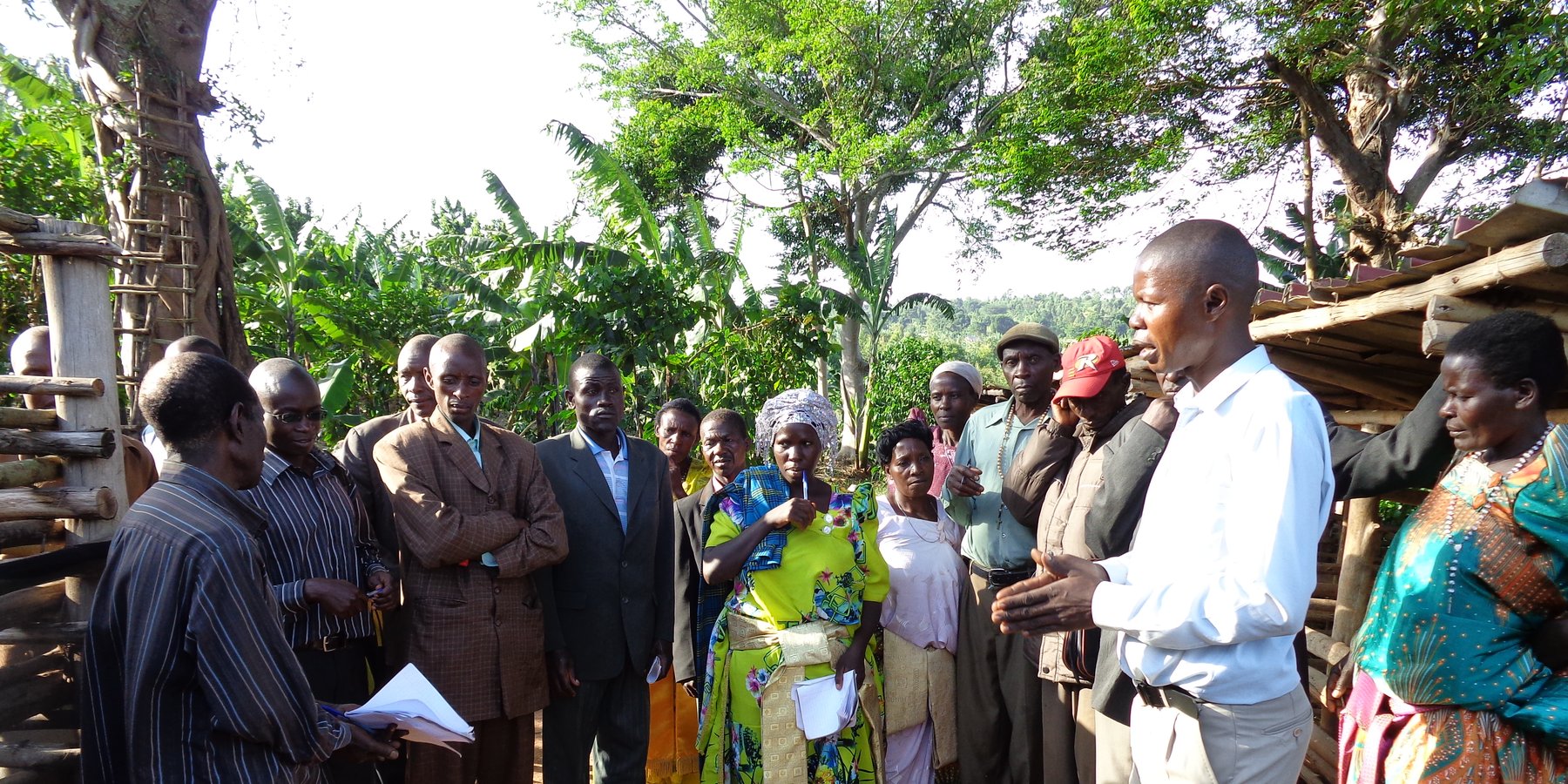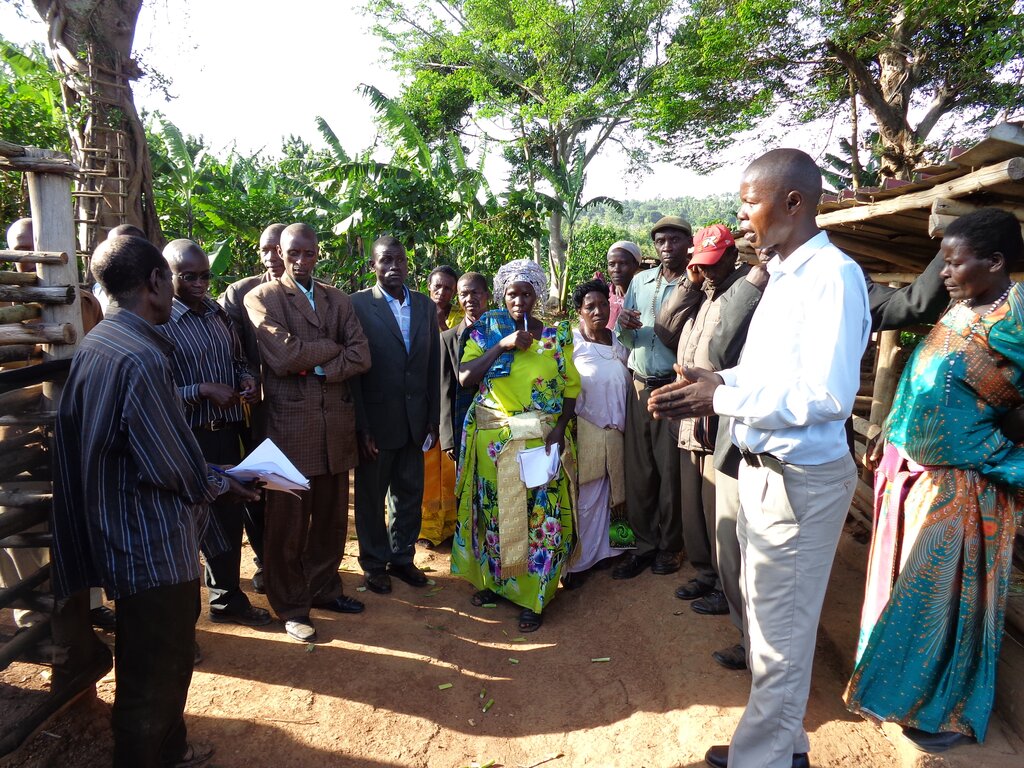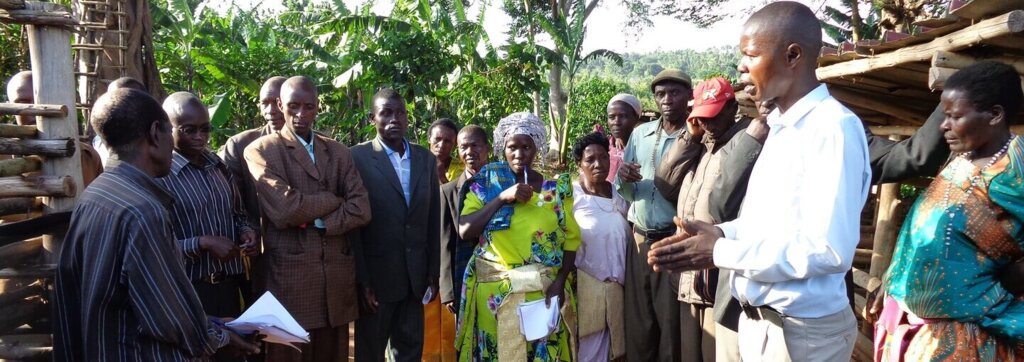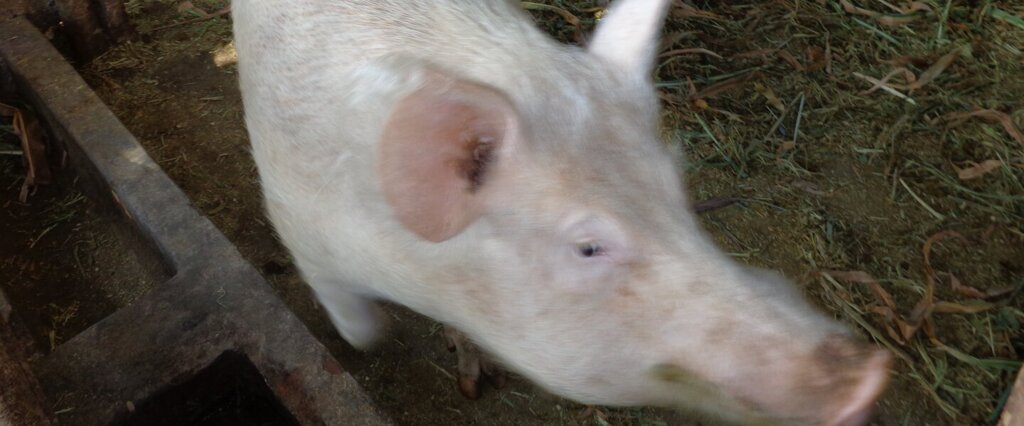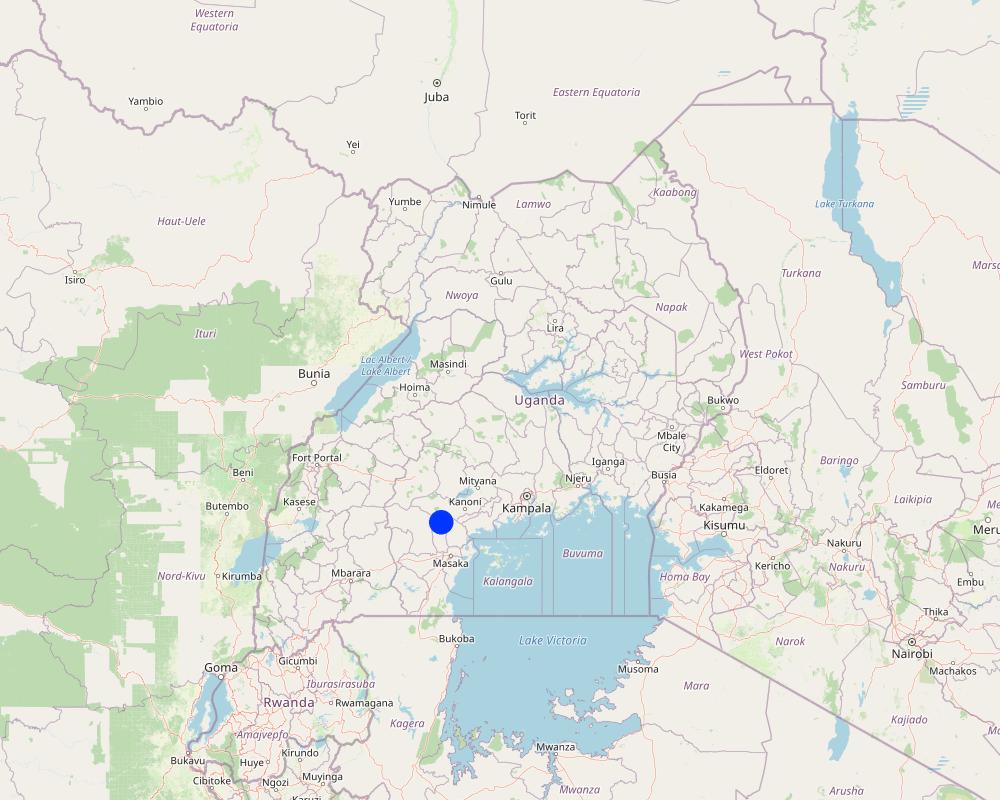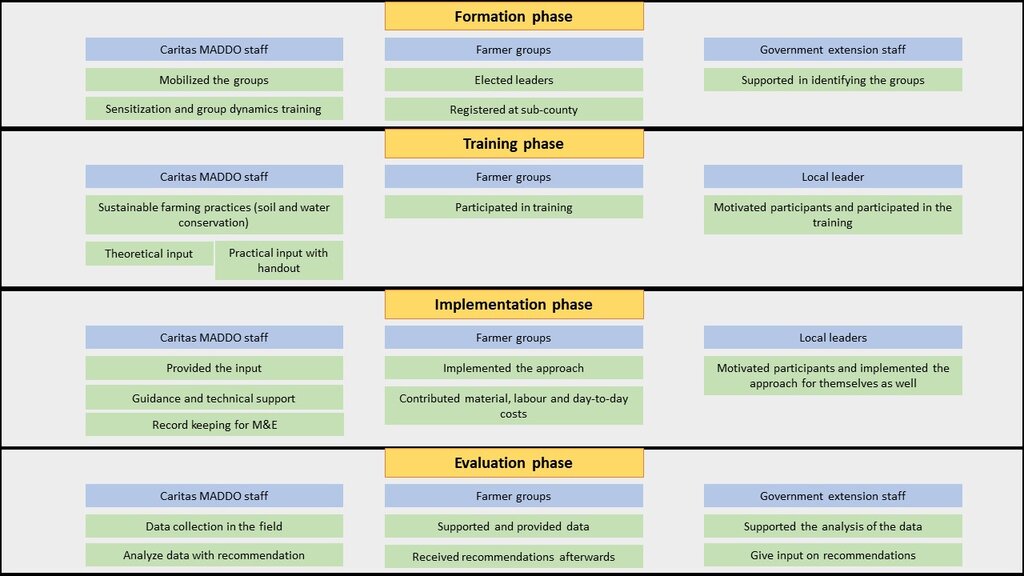MADDO SLM approach [ยูกันดา]
- ผู้สร้างสรรค์:
- การอัพเดท:
- ผู้รวบรวม: Tonny Kyambadde
- ผู้เรียบเรียง: Beatrice Nabukenya, Michael Mulindwa, Kyagaba Prossy, Annika Reimann
- ผู้ตรวจสอบ: William Critchley, Rima Mekdaschi Studer
obugimu bwettaka ngokozesa obusa bwembizzi mu mwannyi ne bitooke
approaches_6370 - ยูกันดา
ดูส่วนย่อย
ขยายทั้งหมด ย่อทั้งหมด1. ข้อมูลทั่วไป
1.2 รายละเอียดที่ติดต่อได้ของผู้รวบรวมและองค์กรที่เกี่ยวข้องในการประเมินและการจัดเตรียมทำเอกสารของแนวทาง
ชื่อของโครงการซึ่งอำนวยความสะดวกในการทำเอกสารหรือการประเมินแนวทาง (ถ้าเกี่ยวข้อง)
Euregio-East Africa Livelihood Improvement Programme (EEALIP)ชื่อของโครงการซึ่งอำนวยความสะดวกในการทำเอกสารหรือการประเมินแนวทาง (ถ้าเกี่ยวข้อง)
Caritas Masaka Diocesan Development Organisation (Caritas MADDO) - ยูกันดา1.3 เงื่อนไขที่เกี่ยวข้องกับการใช้ข้อมูลที่ได้บันทึกไว้ผ่านทาง WOCAT
วันที่เก็บรวบรวมข้อมูล (ภาคสนาม):
14/07/2021
ผู้รวบรวมและวิทยากรหลักยอมรับเงื่อนไขเกี่ยวกับการใช้ข้อมูลที่ถูกบันทึกผ่านทาง WOCAT:
ใช่
1.4 การอ้างอิงถึงแบบสอบถามเรื่องเทคโนโลยี SLM
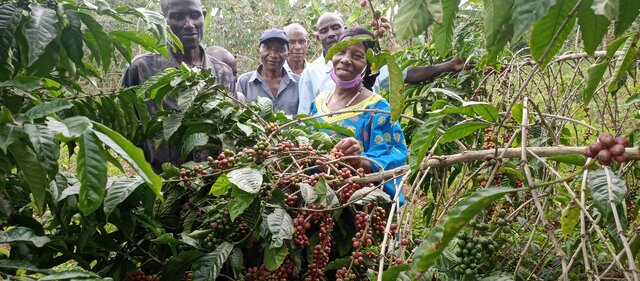
Piggery-Banana-Coffee technology [ยูกันดา]
The "Piggery-Banana-Coffee" sustainable land management technology is a proven practice that significantly improves soil fertility and productivity in an integrated farming system for smallholder farmers in Uganda.
- ผู้รวบรวม: Tonny Kyambadde
2. คำอธิบายของแนวทาง SLM
2.1 การอธิบายแบบสั้น ๆ ของแนวทาง
This integrated soil fertility management approach aims at identifying and promoting practices in land management that can increase soil fertility, reduce land degradation and improve production. Under this specific example, organic manure from a piggery was applied to banana and coffee plantations.
2.2 การอธิบายอย่างละเอียดของแนวทาง
การอธิบายอย่างละเอียดของแนวทาง:
The main objective of the MADDO approach is to test and promote, in a pilot area, the advantages for small-scale farmers of organic manure from piggeries in coffee and banana plantations. The approach aims not only to increase farmers' production through multiple income streams from the integrated production systems but also to secure those income streams by enhancing soil fertility and decreasing land degradation for long-term sustainability. One distinct feature of the approach is the emphasis on cost-effective technologies for small-scale farmers. In the case of the piggery-banana-coffee enterprise, the investment capital needed is very low and the technology is not complicated.
The focus was on small-scale farmer groups of 30-35 members (roughly 200 farmers in 6 groups participated) and was coordinated by Caritas MADDO (one project coordinator and three field staff officers) and agriculture officers from the subcounty level. Groups were identified and implementation concentrated on various trainings for farmers on piggery management, banana and coffee production. In particular, the production of organic manure was highlighted in training, with emphasis on collection, storage and application. After basic training, farmers are led through the one-year production cycle which includes the following stages: rearing of the pigs; manure collection; storage in a pit for decomposition (one to two months); application of the manure during the rainy season when the plants are healthy and actively growing; and then ongoing monitoring, and if needed repetition of the stages and reapplication of the manure (two times per year).
The small-scale farmers appreciate the technology because of the higher production and income they are gaining. It is easy and cheap - particularly because the enterprise can be spread by beneficiary farmers passing on piglets to new farmers. Nevertheless, there is the possibility of the pigs catching diseases (African swine fever) and once infected the farmers have no options for relief as an entire piggery can be wiped out. Moreover, farmers have complained that water scarcity and unsuitable weather conditions can affect production.
2.3 รูปภาพของแนวทาง
2.5 ประเทศ ภูมิภาค หรือสถานที่ตั้งที่ได้นำแนวทางไปใช้
ประเทศ:
ยูกันดา
ภูมิภาค/รัฐ/จังหวัด: :
Central Region
ข้อมูลเฉพาะเพิ่มเติมของสถานที่ตั้ง:
Lutugunda village in Bukomansimbi district
Map
×2.6 วันที่เริ่มต้นและสิ้นสุดของแนวทาง
ถ้าไม่รู้ปีที่แน่นอนให้ประมาณวันที่ที่ริเริ่มใช้แนวทางนี้ :
มากกว่า 50 ปี (แบบดั้งเดิม)
ความคิดเห็น:
The approach is based on the Piggery Banana-Coffee Sustainable Land Management technology that has been practiced for years in the project area. The Euregio project has just promoted the approach and technology recently again.
2.7 ประเภทของแนวทาง
- เป็นนวัตกรรมท้องถิ่นล่าสุด/ นวัตกรรมใหม่
2.8 เป้าหมายหรือวัตถุประสงค์หลักของแนวทาง
The main objective of the approach from an organizational perspective was to test in a pilot area the advantages of organic manure from piggery in a coffee and banana plantation. The approach aims not only to increase farmers' production through multiple income streams from piggery, banana and coffee but also to secure those income streams by enhancing the soil fertility and decreasing land degradation for long-term sustainability.
2.9 เงื่อนไขที่เอื้ออำนวยหรือเป็นอุปสรรคต่อการนำเทคโนโลยีภายใต้แนวทางนี้ไปปฏิบัติใช้
บรรทัดฐานและค่านิยมทางสังคม วัฒนธรรม ศาสนา
- เอื้ออำนวย
Piggeries are common among the groups
การมีไว้ให้หรือการเข้าถึงแหล่งการเงินและบริการ
- เอื้ออำนวย
Input supply was provided
การจัดตั้งระดับองค์กร
- เอื้ออำนวย
With the presence of the extension officers from the government and other NGOs in the area
การร่วมมือหรือการทำงานประสานกันของผู้ลงมือปฏิบัติ
- เอื้ออำนวย
Collaboration was part of the overall project design
กรอบแนวทางในการดำเนินการด้านกฎหมาย (การถือครองที่ดิน สิทธิในการใช้ที่ดินและน้ำ)
- เอื้ออำนวย
only customary rights practices, but no conflicts
นโยบาย
- เอื้ออำนวย
การกำกับดูแลที่ดิน (การตัดสินใจ การนำเอาไปปฏิบัติใช้ และการบังคับใช้)
- เอื้ออำนวย
ความรู้เกี่ยวกับ SLM การเข้าถึงการสนับสนุนด้านเทคนิค
- เอื้ออำนวย
ตลาด (จัดซื้อปัจจัยนำเข้า ขายผลิตภัณฑ์) และราคา
- เอื้ออำนวย
In particular piggery has a high market in the area
ปริมาณงานที่ทำได้ กำลังคนที่มีให้
- เอื้ออำนวย
3. การมีส่วนร่วมและบทบาทของผู้มีส่วนได้ส่วนเสียที่เกี่ยวข้อง
3.1 ผู้มีส่วนได้ส่วนเสียที่เกี่ยวข้องในแนวทางนี้และบทบาท
- ผู้ใช้ที่ดินระดับท้องถิ่นหรือชุมชนระดับท้องถิ่น
Stakeholders centered around the small-scale farmers (one group of 30-35 members)
- องค์กรที่ขึ้นอยู่กับชุมชน
Caritas MADDO
- ผู้เชี่ยวชาญ SLM หรือที่ปรึกษาการเกษตร
Agriculture extension officers from subcounty
- องค์กรพัฒนาเอกชน
Caritas MADDO
- รัฐบาลระดับท้องถิ่น
3.2 การเกี่ยวข้องของผู้ใช้ที่ดินระดับท้องถิ่นหรือชุมชนระดับท้องถิ่นในช่วงต่างๆของแนวทาง
| ความเกี่ยวข้องของผู้ใช้ที่ดินระดับท้องถิ่นหรือชุมชนระดับท้องถิ่น | ระบุผู้ที่มีส่วนเกี่ยวข้องและอธิบายกิจกรรม | |
|---|---|---|
| การริเริ่มหรือการจูงใจ | ปฏิสัมพันธ์ | The project team involved the community leaders and farmers from prior project phases as well as governmental extension officers have been involved in the initiation of the approach. Activities encompasses the joint group formation and mobilization of fellow farmers to discuss the training needs and capacities. |
| การวางแผน | ปฏิสัมพันธ์ | The above people then continued with jointly discuss the modus operantes with creating a training schedule and actively participating in the learning journey. |
| การดำเนินการ | ระดมกำลังด้วยตนเอง | The implementation mainly encompasses the adoption of the SLM technology, and the farmers were the main implementors and actors with offering pilot land and labor. The project contributed advisory support, monitoring and financial support. |
| การติดตามตรวจสอบหรือการประเมินผล | ปฏิสัมพันธ์ | M&E was done by the project staff, extension officers and the farmers together with the community leaders themselves on a regular basis. |
3.3 แผนผังแสดงขั้นตอนการทำงาน (ถ้ามี)
3.4 การตัดสินใจเลือกใช้เทคโนโลยี SLM
ระบุผู้ที่ทำการตัดสินใจเลือกเทคโนโลยีมากกว่าหนึ่งวิธีไปปฏิบัติใช้:
- ผู้ใช้ที่ดินเป็นผู้ตัดสินใจหลัก โดยการสนับสนุนจากผู้เชี่ยวชาญ SLM
การอธิบาย:
Mainly land users, supported by implementing organization
ระบุว่าการตัดสินใจตั้งอยู่บนพื้นฐานของ:
- ประสบการณ์และความคิดเห็นส่วนตัว (ไม่ได้ลงบันทึกไว้)
4. การสนับสนุนด้านเทคนิค การสร้างขีดความสามารถ และการจัดการด้านความรู้
4.1 การสร้างขีดความสามารถ / การอบรม
ได้มีการจัดอบรมให้แก่ผู้ใช้ที่ดินหรือผู้มีส่วนได้ส่วนเสียคนอื่น ๆ หรือไม่:
ใช่
ให้ระบุว่าใครเป็นผู้ได้รับการอบรม:
- ผู้ใช้ที่ดิน
- เจ้าหน้าที่ภาคสนาม / ที่ปรึกษา
รูปแบบการอบรม:
- กำลังดำเนินการ
- เกษตรกรกับเกษตรกร
หัวข้อที่พูด:
Land and soil management
Sustainable agricultural practices
Piggery management
4.2 การบริการให้คำแนะนำ
ผู้ใช้ที่ดินมีการเข้าถึงการรับบริการให้คำปรึกษาหรือไม่:
ใช่
ระบุว่ามีบริการให้คำปรึกษาหรือไม่:
- ไปเยี่ยมชมสถานที่
4.3 การเสริมความแข็งแกร่งให้กับสถาบัน (การพัฒนาองค์กร)
สถาบันได้รับการจัดตั้งขึ้นมาหรือเสริมความแข็งแกร่งโดยแนวทางนี้หรือไม่:
- ใช่ เล็กน้อย
ระบุระดับของสถาบันที่ได้รับการเสริมความแข็งแกร่งหรือจัดตั้งขึ้นมา:
- ท้องถิ่น
ระบุประเภทของการให้ความช่วยเหลือสนับสนุน:
- การสร้างขีดความสามารถ / การอบรม
ให้รายละเอียดเพิ่มเติม :
Input support
4.4 การติดตามตรวจสอบและประเมินผล
การติดตามตรวจสอบและประเมินผลเป็นส่วนหนึ่งของแนวทางหรือไม่:
ใช่
ถ้าตอบว่าใช่ แสดงว่าการจัดเตรียมเอกสารนี้มุ่งหวังที่จะเอาไปใช้สำหรับการติดตามตรวจสอบและประเมินผลใช่หรือไม่:
ใช่
4.5 การวิจัย
การวิจัยเป็นส่วนหนึ่งของแนวทางหรือไม่:
ใช่
ระบุหัวข้อเรื่อง:
- นิเวศวิทยา
ให้ข้อมูลเพิ่มเติมและให้ระบุผู้ทำการวิจัย:
Project staff was during minor research on soil improvement and in particular on fitting livestock integrations. Due to this research pigs were chosen as preferred livestock.
5. การสนับสนุนด้านการเงินและวัสดุอุปกรณ์
5.1 ระบุงบประมาณประจำปีสำหรับแนวทาง SLM นี้
ระบุงบประมาณประจำปีสำหรับแนวทาง SLM นี้ เป็นหน่วยดอลลาร์สหรัฐ:
50000.00
ถ้าหากว่างบประมาณประจำปีไม่เป็นที่ทราบแน่นอน ให้ระบุช่วงลงไป:
- 10,000-100,000
แสดงความคิดเห็น (แหล่งของการระดมทุน ผู้บริจาคคนสำคัญ):
The budget includes staff salary, transport, training costs and inputs for the farmers. In total the approach reached around 200 farmers within six groups in Bukomansimbi (30-35 participants each).
5.2 การสนับสนุนด้านการเงิน / วัสดุอุปกรณ์ให้แก่ผู้ใช้ที่ดิน
ผู้ใช้ที่ดินได้รับการสนับสนุนด้านการเงิน / วัสดุอุปกรณ์ไปปฏิบัติใช้เทคโนโลยีหรือไม่:
ใช่
ถ้าใช่ ให้ระบุประเภทของการสนับสนุน เงื่อนไขและผู้จัดหามาให้:
Land users were given input support (coffee seedlings, banana suckers, pigs)
5.3 เงินสนับสนุนสำหรับปัจจัยนำเข้า (รวมถึงแรงงาน)
- ไม่มี
- การเกษตร
| ระบุปัจจัยนำเข้าที่ได้รับการสนับสนุน | เห็นด้วยระดับไหน | ระบุเงินสนับสนุน |
|---|
ถ้าแรงงานโดยผู้ใช้ที่ดินเป็นปัจจัยนำเข้าที่มีอยู่มากมาย ระบุด้วยว่าเนื่องจาก:
- สมัครใจ
5.4 เครดิต
มีการจัดหาเครดิตมาให้ภายใต้แนวทาง SLM หรือไม่:
ไม่ใช่
5.5 แรงจูงใจหรือเครื่องมืออื่น ๆ
แรงจูงใจหรือเครื่องมืออื่น ๆ ได้ถูกนำไปใช้ส่งเสริมการใช้เทคโนโลยี SLM หรือไม่:
ไม่ใช่
6. การวิเคราะห์ผลกระทบและการสรุป
6.1 ผลกระทบของแนวทาง
ทำให้ผู้ใช้ที่ดินระดับท้องถิ่นมีอำนาจขึ้น ปรับปรุงการเข้าร่วมของผู้มีส่วนได้ส่วนเสียให้ดีขึ้นหรือไม่:
- ไม่ใช่
- ใช่ เล็กน้อย
- ใช่ ปานกลาง
- ใช่ อย่างมาก
Technical knowledge of improved management was testified by local land users and group cohesion was strengthened through community labor pooling.
The piloting of the approach lead to evidence decision-making in the form that farmers know about the advantage of the organic manure in increasing soil fertility and increased production.
Agriculture extension officer
In particular women were part of the test group (80 %)
7 farmers were youth (under 30 years) in the group
Training on hygiene of the piggery was given. Moreover, farmers mobilized for underground water tanks (positive side effect of the approach)
Prevents soil degradation
6.2 แรงจูงใจหลักของผู้ใช้ที่ดินเพื่อที่จะนำ SLM ไปปฏิบัติใช้
- การผลิตที่เพิ่มขึ้น
A pulling factor was the fast economic benefit and food security for the participants.
- กำไร (ความสามารถ) อัตราส่วนค่าใช้จ่ายต่อผลประโยชน์ที่เพิ่มขึ้น
Income was increased through the multiple income streams.
- การจ่ายเงินหรือการช่วยเหลือ
The Euregio project was contributing inputs required for the technology.
- ความรู้และทักษะ SLM ที่เพิ่มพูนขึ้น
Curiosity and eagerness to learn about the approach and technology.
6.3 ความยั่งยืนของกิจกรรมของแนวทาง
ผู้ใช้ที่ดินสามารถทำให้สิ่งต่างๆ ที่ได้ปฏิบัติใช้โดยแนวทางนี้ยั่งยืนได้หรือไม่ (โดยไม่มีการสนับสนุนจากภายนอก):
- ใช่
ถ้าตอบว่าใช่ ให้อธิบายว่าอย่างไร :
With the pass on mechanisms of the pigs and the capacity building through the extension officers. The pass on mechanisms works similar to the Heifer pass on, where participating farmers have to contribute their newborn piglets to other members within the group that have not benefited from the prior project input.
6.4 จุดแข็งและข้อได้เปรียบของแนวทาง
| จุดแข็ง / ข้อได้เปรียบของแนวทางในทัศนคติของผู้ใช้ที่ดิน |
|---|
| The pilot small-scale farmers appreciate the approach because of the higher production and income there are gaining. The approach is easy and cheap to be implemented and in particular because a pass-on mechanisms of the pigs were applied. |
| จุดแข็ง / ข้อได้เปรียบของแนวทางในทัศนคติของผู้รวบรวมหรือวิทยากรหลัก |
|---|
| Advantages was in the participatory approach, and it was an interactive learning experience |
6.5 จุดอ่อน / ข้อเสียเปรียบของแนวทางและวิธีในการแก้ไข
| จุดอ่อน / ข้อเสียเปรียบในทัศนคติของผู้ใช้ที่ดิน | สามารถแก้ไขปัญหาได้อย่างไร |
|---|---|
| The approach is unfortunately affected by the possibility of the pigs catching diseases (African swine fever) and once infected the farmers have no options for relief as entire piggery will be wiped out. | Hygiene training was given and practiced |
| Moreover, farmers have complained that water scarcity and unsuitable weather conditions have affected the approach. | Farmers mobilized for underground water tanks |
| จุดอ่อน / ข้อเสียเปรียบในทัศนคติของผู้รวบรวมหรือวิทยากรหลัก | สามารถแก้ไขปัญหาได้อย่างไร |
|---|---|
| For the compilers it was difficult to access some of the Information from farmers (e.g., basic records on feeding or construction) | Training was given and also information was collected together with farmers (e.g. calculation made together on construction costs) |
7. การอ้างอิงและการเชื่อมต่อ
7.1 วิธีการหรือแหล่งข้อมูล
- ไปเยี่ยมชมภาคสนาม การสำรวจพื้นที่ภาคสนาม
Roughly 20 field visits have been conducted (without trainings) to the participating groups.
- การสัมภาษณ์กับผู้ใช้ที่ดิน
Interviews have been done on group level and individually. Mainly the participating farmers, community leaders and extension officers have been interviewed by the project staff to gain data and to validate information.
- การเก็บรวบรวมมาจากรายงานและเอกสารที่มีอยู่
Sustainable Agricultural Practice trainings and manual (from Caritas MADDO) and literature used for the technology
7.2 การอ้างอิงถึงสิ่งตีพิมพ์
ชื่อเรื่อง ผู้เขียน ปี ISBN:
Not used
7.3 เชื่อมโยงกับข้อมูลที่มีอยู่บนออนไลน์
ชื่อเรื่องหรือคำอธิบาย:
Not used
ลิงก์และโมดูล
ขยายทั้งหมด ย่อทั้งหมดลิงก์

Piggery-Banana-Coffee technology [ยูกันดา]
The "Piggery-Banana-Coffee" sustainable land management technology is a proven practice that significantly improves soil fertility and productivity in an integrated farming system for smallholder farmers in Uganda.
- ผู้รวบรวม: Tonny Kyambadde
โมดูล
ไม่มีโมดูล


